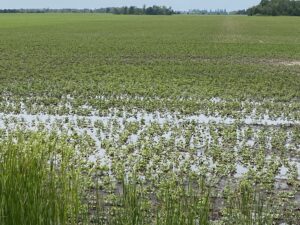New corn hybrid DON screening report
SUPPORTING DISEASE MANAGEMENT DECISIONS

A NEW REPORT WILL HELP ONTARIO CORN GROWERS ASSESS the risks of gibberella ear rot and deoxynivalenol (DON) accumulation in corn hybrids. The Ontario Corn Hybrid DON Screening Trials 2023 Report, released by the Ontario Corn Committee (OCC) in February 2024, offers the latest information on hybrid screening research, providing growers with a valuable agronomic management tool.
“This inaugural report provides a risk assessment of hybrids entering the 2023 trials, along with a multi-year assessment on the same hybrids where data was available,” explains Dr. Dave Hooker, associate professor at the University of Guelph Ridgetown Campus and Albert Tenuta, OMAFRA field crop pathologist, lead researchers on this project.
An epidemic of gibberella ear rot that prompted the research in the fall of 2018 that saw some of the highest DON concentrations on record, costing Ontario farmers an estimated $200 million. Tenuta explains that as a result, a group of industry stakeholders came together to ask, ‘How can we reduce the risk of this infectious and devastating disease?’.
“A few decades ago, our industry developed integrated management practices for DON in wheat,” says Hooker. “And that’s what we needed to do to manage DON in corn.”
RESEARCH COLLABORATION
Hooker explains that gibberella ear rot is concerning because of the resulting DON concentrations. And, since DON concentrations are highly dependent on interactions among hybrids, pathogens, and the environment, the OCC began refining protocols for testing hybrid sensitivity to DON. “We’ve known for decades that some corn hybrids (the disease host) are genetically more susceptible to accumulating DON than others, but before 2019, the industry had never collaborated on an effort to screen hybrids.”
The research began in 2019, and Hooker describes the approach as multifaceted and immense. The project involved exploring so many factors, including reducing grain corn testing variability at receiving elevators, fungicide chemistry and application technologies, grain storage, cropping system effects like crop rotation and tillage systems, DON prediction modelling (similar to DONcast for wheat) with weather and agronomic variables, and corn hybrid screening for DON accumulation.
The team was led by the Grain Farmers of Ontario, the Ontario Ministry of Agriculture, Food and Rural Affairs (OMAFRA) and the University of Guelph Ridgetown Campus, along with companies and members of the corn industry value chain.
“Evaluating genetic differences is very complex because it is highly dependant on the environment,” says Hooker.
One of the project’s key objectives was to develop and refine the methods in the screening trials to achieve more accurate risk assessments of various corn hybrids to accumulate DON relative to a known highly susceptible check hybrid. Tenuta notes seed companies also compared the results of their hybrids from this project with their research and development.
MANAGING DISEASE RISK
“The main objective of the work since 2019 was to refine the protocols for more accurate hybrid DON risk assessments,” says Hooker. “We needed to be confident that the data would mirror those in on-farm environments.”
In 2019, the project’s first year, the team learned that DON concentrations were highly correlated with the silking date of each hybrid. “In other words, the DON concentrations depended more on the environmental conditions, mainly temperature, when the hybrids silked rather than the genetic hybrid tolerance against DON accumulation,” explains Hooker.
Experiments were conducted in small-plot trials across Ontario in environmental conditions favourable for gibberrella ear rot disease and DON accumulation and in the presence of the pathogen that causes the disease. This approach represented two of three sides of the disease triangle – the environment must be favourable, the pathogen must be present and the host must be susceptible for disease to occur.
“For the pathogen side, we inoculated corn silks on each plant by hand at the time most favourable for infection. For the environment side of the triangle, we mist-irrigated the corn for four weeks from silking, which increased wetness and humidity levels within the corn canopy,” explains Hooker. “The various hybrids represented the third side of the triangle – where the corn hybrids were assessed for genetic resistance or tolerance to the disease and DON accumulation.” Since 2020, other major adjustments have been made, including inoculum loads applied to the silks, the inoculation technique to reduce variability when spraying inoculum on silks, and the timing of inoculation based on silking date.
NEW GENETIC ASSESSMENT TOOL
The results of this multi-year study are now available for Ontario growers in The Ontario Corn Hybrid DON Screening Trials 2023 Report on the OCC website (www.gocrops.ca).
Hooker and Tenuta agree the success of this project is a result of the collaborative approach that began with the gibberella ear rot epidemic in 2018 and brought farmers, end-users, seed companies, Grain Farmers of Ontario, OMAFRA, and the University of Guelph Ridgetown Campus together to address an industry-wide problem.
“As we expected, the project was challenging because we knew that the disease and the DON it produces are highly complex, but I’m not aware of any project that had more collaboration and goal to help the entire industry manage this serious agronomic challenge,” says Hooker.
Currently, there are no DON-resistant hybrids, and Hooker reminds growers that the information presented in the report is a relative risk assessment of hybrids. He says additional data sources like seed company information and field trial results should be included in hybrid decisions based on DON risk. “Genetics are just one piece of the puzzle; there are other disease management factors that need to be considered too,” notes Hooker.
For now, Hooker and Tenuta are pleased with the results. “We have a new protocol for assessing hybrids that provides farmers with more information for choosing hybrids that are more resistant to DON accumulation.” •


























